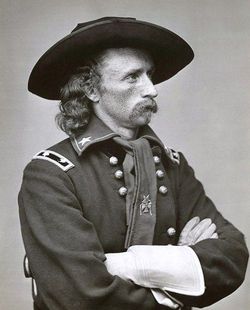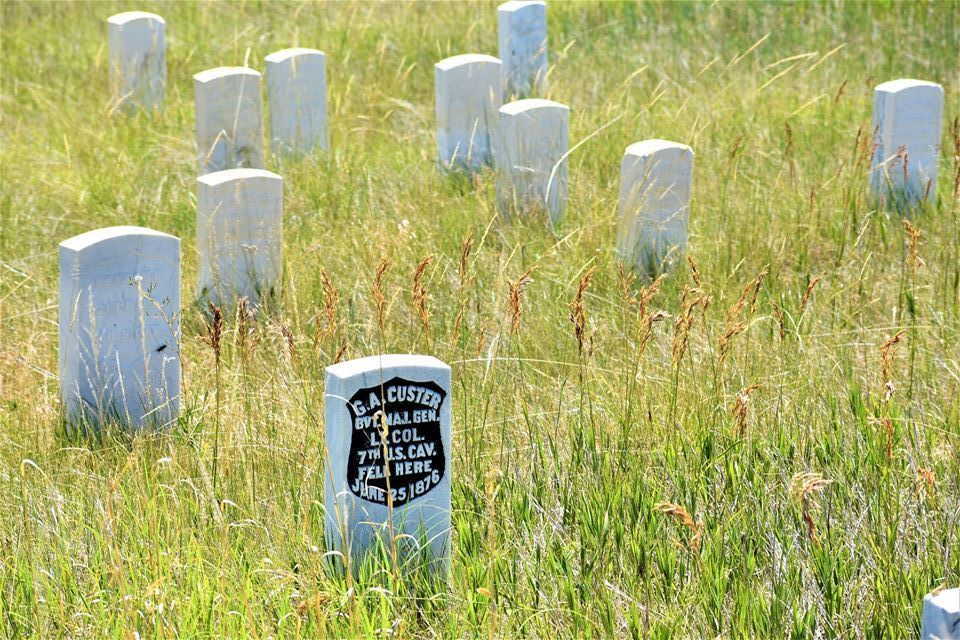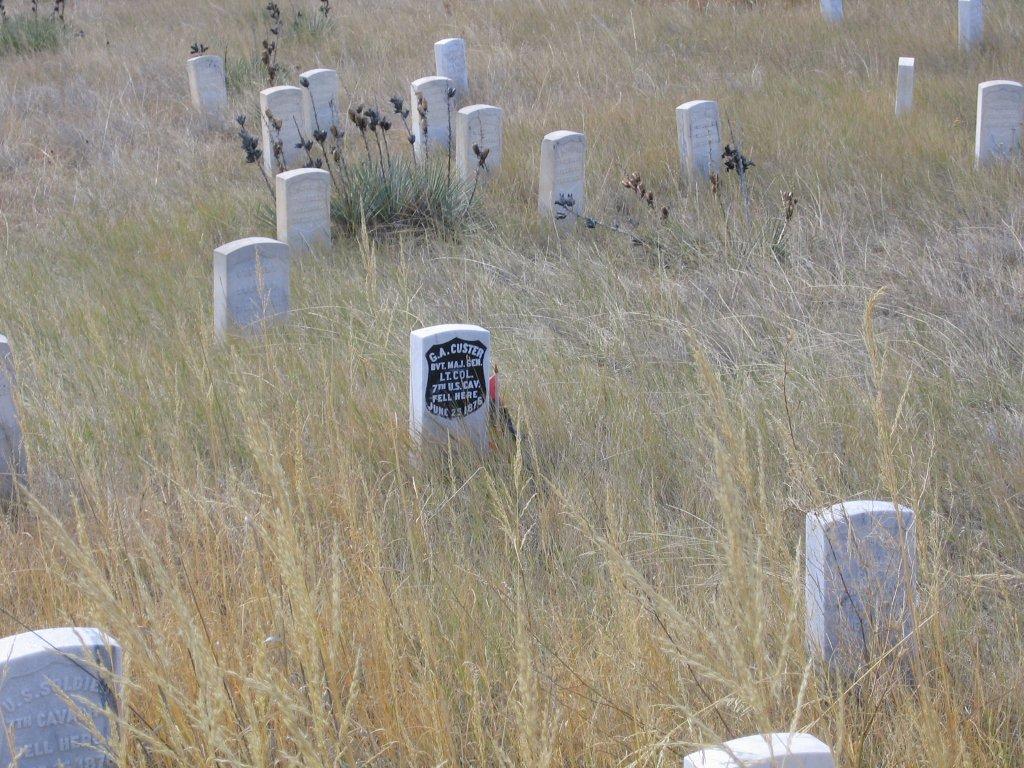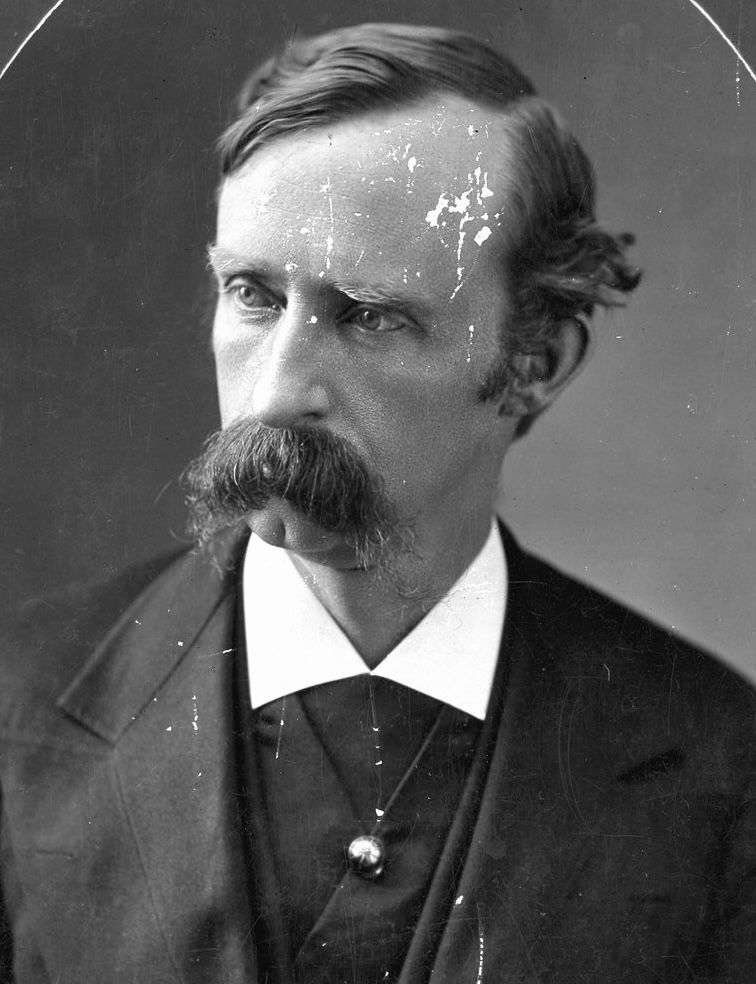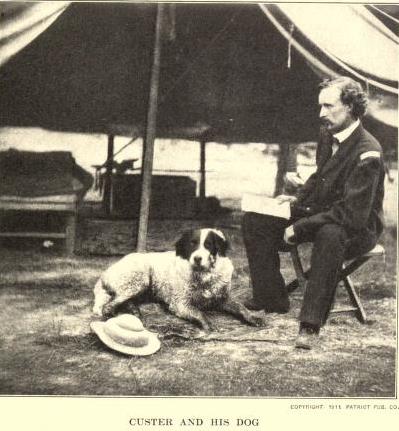United States Army Brigadier General. He is remembered as one of the most famous and controversial figures in the United States military history. His "Last Stand" made a mark in American history books. He came to Michigan as a boy to live with a half-sister. Being independent by breaking rules at West Point, he received 726 demerits in four years, one of the highest in the Academy's history. Graduating last in the West Point Class of 1861, he spent the first part of the American Civil War as a courier and staff officer. Prior to July 1, 1863, the start of the Battle of Gettysburg, he was promoted from Captain to Brigadier General of Volunteers, given command of the Michigan "Wolverine" Cavalry, and called the "Boy General." He helped to defeat General Jeb Stuart's attempt to make a cavalry strike behind Union lines on the 3rd day of the battle, thus markedly contributing to the Army of Potomac's victory. Custer's brigade lost 257 men at Gettysburg, which was the highest of any Union cavalry brigade. He was awarded a Regular Army Brevet promotion to the rank of Major, and a large monument dedicated to his brigade stands on the East Cavalry Field at Gettysburg. From that point until the end of the war, he participated in nearly every cavalry action in Virginia, always performing boldly, most often brilliantly, and not as a humble man; he was always seeking a publicity for himself and his action. Along with General Sheridan, he participated in the burning of the South, thus receiving much recognition and appearing on the cover of Harper's Weekly magazine. He was present at General Robert E. Lee's surrender, and later, General Sheridan gave Custer's wife, Libbie, the table used to sign the document of the Confederacy's surrender. The table was later donated to the Smithsonian National Museum. He ended the war at the rank of Major General of Volunteers and a Brevet Major General in the Regular Army. After the war, he toyed with the ideas of accepting an offer of: entering into a private railroad business; a position as Adjutant General of the Army of Benito Juarez of Mexico, who was fighting Mexican Emperor Maximilian I; or being a candidate for United States Congress from Michigan. He refused all of these offers. Upon the United States Army reorganization in 1866, he was appointed Lieutenant Colonel of the 7th United States Cavalry. Fighting in various actions against the tribes of Native Americans, he destroyed an entire Cheyenne village in the Battle of Washita River in November of 1868. His exploits on the plains were romanticized by the newspapers in the East, elevating him to a legend in his own time. In 1874, he wrote numerous articles on the politics of the Wild West and Native Americans, which were published in the book "My Life on the Plains." In 1875, he testified against Secretary of War William W. Belknap in his impeachment becoming at odds with President Grant and losing his command for a short time. His military career culminated in the June 25, 1876, Battle of Little Big Horn and his "Last Stand," where he and his regiment, including his brother, Tom, who was a Double Medal of Honor Recipient, were killed in one of the best-known military actions of the 19th century. A Native American guide and a horse survived. To this day, Custer's deeds and place in history is debated in historical controversy. His brilliant Civil War record cannot be overlooked nor can his brutal participation in the Indian Wars. Besides Custer State Park in South Dakota and Little Big Horn Battlefield National Monument in Montana, there are numerous counties and cities throughout the United States named "Custer" in his honor. He has been the subject of countless songs, books (including the ones written by his wife), paintings (including the ones mass-distributed by the Anheuser-Busch Brewing Company), and Hollywood movies. His body was originally buried in a shallow grave on the battle field, and a year later, he was interred with full military honors at West Point Cemetery on October 10, 1877. In 1879, the battlefield was designated as a National Cemetery.
United States Army Brigadier General. He is remembered as one of the most famous and controversial figures in the United States military history. His "Last Stand" made a mark in American history books. He came to Michigan as a boy to live with a half-sister. Being independent by breaking rules at West Point, he received 726 demerits in four years, one of the highest in the Academy's history. Graduating last in the West Point Class of 1861, he spent the first part of the American Civil War as a courier and staff officer. Prior to July 1, 1863, the start of the Battle of Gettysburg, he was promoted from Captain to Brigadier General of Volunteers, given command of the Michigan "Wolverine" Cavalry, and called the "Boy General." He helped to defeat General Jeb Stuart's attempt to make a cavalry strike behind Union lines on the 3rd day of the battle, thus markedly contributing to the Army of Potomac's victory. Custer's brigade lost 257 men at Gettysburg, which was the highest of any Union cavalry brigade. He was awarded a Regular Army Brevet promotion to the rank of Major, and a large monument dedicated to his brigade stands on the East Cavalry Field at Gettysburg. From that point until the end of the war, he participated in nearly every cavalry action in Virginia, always performing boldly, most often brilliantly, and not as a humble man; he was always seeking a publicity for himself and his action. Along with General Sheridan, he participated in the burning of the South, thus receiving much recognition and appearing on the cover of Harper's Weekly magazine. He was present at General Robert E. Lee's surrender, and later, General Sheridan gave Custer's wife, Libbie, the table used to sign the document of the Confederacy's surrender. The table was later donated to the Smithsonian National Museum. He ended the war at the rank of Major General of Volunteers and a Brevet Major General in the Regular Army. After the war, he toyed with the ideas of accepting an offer of: entering into a private railroad business; a position as Adjutant General of the Army of Benito Juarez of Mexico, who was fighting Mexican Emperor Maximilian I; or being a candidate for United States Congress from Michigan. He refused all of these offers. Upon the United States Army reorganization in 1866, he was appointed Lieutenant Colonel of the 7th United States Cavalry. Fighting in various actions against the tribes of Native Americans, he destroyed an entire Cheyenne village in the Battle of Washita River in November of 1868. His exploits on the plains were romanticized by the newspapers in the East, elevating him to a legend in his own time. In 1874, he wrote numerous articles on the politics of the Wild West and Native Americans, which were published in the book "My Life on the Plains." In 1875, he testified against Secretary of War William W. Belknap in his impeachment becoming at odds with President Grant and losing his command for a short time. His military career culminated in the June 25, 1876, Battle of Little Big Horn and his "Last Stand," where he and his regiment, including his brother, Tom, who was a Double Medal of Honor Recipient, were killed in one of the best-known military actions of the 19th century. A Native American guide and a horse survived. To this day, Custer's deeds and place in history is debated in historical controversy. His brilliant Civil War record cannot be overlooked nor can his brutal participation in the Indian Wars. Besides Custer State Park in South Dakota and Little Big Horn Battlefield National Monument in Montana, there are numerous counties and cities throughout the United States named "Custer" in his honor. He has been the subject of countless songs, books (including the ones written by his wife), paintings (including the ones mass-distributed by the Anheuser-Busch Brewing Company), and Hollywood movies. His body was originally buried in a shallow grave on the battle field, and a year later, he was interred with full military honors at West Point Cemetery on October 10, 1877. In 1879, the battlefield was designated as a National Cemetery.
Bio by: Linda Davis
Inscription
G.A. CUSTER
BVT. MAJ. GEN.
7th U.S. CAV.
FELL HERE
JUNE 25, 1876
Family Members
Advertisement
See more Custer memorials in:
Explore more
Sponsored by Ancestry
Advertisement
